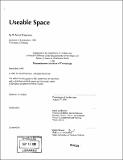| dc.contributor.advisor | Mark Jarzombek. | en_US |
| dc.contributor.author | Francisco, B. Scott | en_US |
| dc.contributor.other | Massachusetts Institute of Technology. Dept. of Architecture. | en_US |
| dc.date.accessioned | 2006-07-31T15:29:25Z | |
| dc.date.available | 2006-07-31T15:29:25Z | |
| dc.date.copyright | 2005 | en_US |
| dc.date.issued | 2005 | en_US |
| dc.identifier.uri | http://hdl.handle.net/1721.1/33741 | |
| dc.description | Thesis (S.M.)--Massachusetts Institute of Technology, Dept. of Architecture, 2005. | en_US |
| dc.description | Includes bibliographical references. | en_US |
| dc.description.abstract | A study was carried out to explore methods for improving the understanding and practice of design as a means of self-discovery, intersubjective dialogue and cultural development. Using the Massachusetts Institute of Technology as a laboratory and case study, a series of interventions and observations were conducted and recorded. Key concerns were the dialectical relationships between individuals and organization, freedom and language, play and structure, dialogue and community, design and technological systems. The hypothesis was that the pervasive effect of post-structural thinking in architectural theory and design education have created an environment that does not adequately prepare students to explore, engage and communicate personal values in their work, particularly in relation to the immediate contexts in which they find themselves. It also posited that an emphasis on technological systems rather than tectonic and social skill building becomes an additional obstacle to dialogical self-expression and cultural development. The indeterminacy of this hypothesis lead to a series of participatory design proposals with the intent to impact the community context of the Institute. | en_US |
| dc.description.abstract | (cont.) One of these proposals, a small cafe, was structurally implemented and became a reference point for observation and theoretical analysis. The research concluded that architecture studies would be invigorated by embracing the specific and multiple structures of communication that architecture offers - embodied in the concept of symbolic action. These studies should also include the practice of dialogue: personal, conflictual and poetic self-expression as means of contextual transformation and transcendence. This process was best encapsulated in the notion of design as rhetoric - a play of actors engaging contextual structure, personal values and a belief in human communality. | en_US |
| dc.description.statementofresponsibility | by B. Scott Francisco. | en_US |
| dc.format.extent | 132 p. | en_US |
| dc.format.extent | 6906313 bytes | |
| dc.format.extent | 6911826 bytes | |
| dc.format.mimetype | application/pdf | |
| dc.format.mimetype | application/pdf | |
| dc.language.iso | eng | en_US |
| dc.publisher | Massachusetts Institute of Technology | en_US |
| dc.rights | M.I.T. theses are protected by copyright. They may be viewed from this source for any purpose, but reproduction or distribution in any format is prohibited without written permission. See provided URL for inquiries about permission. | en_US |
| dc.rights.uri | http://dspace.mit.edu/handle/1721.1/7582 | |
| dc.subject | Architecture. | en_US |
| dc.title | Useable space | en_US |
| dc.title.alternative | Usable space | en_US |
| dc.type | Thesis | en_US |
| dc.description.degree | S.M. | en_US |
| dc.contributor.department | Massachusetts Institute of Technology. Department of Architecture | |
| dc.identifier.oclc | 65177452 | en_US |
